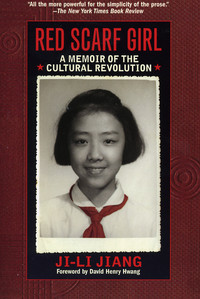
|
The Cultural Revolution in China |

|
China has become a huge influence in the world, economically and politically. In reading Red Scarf Girl, we have the opportunity to see what the not too distant past has held for this nation. It makes you wonder what the present China is really like! The Red Scarf Girl: A Memoir of the Cultural Revolution by Ji-li Jiang. (Reading Unit) Summary: Ji-li Jiang who turned 12 in 1966 lived in Shanghai, China. She had a family who adored her, was an excellent student admired by teachers and classmates, and was a Young Pioneer. Being a Young Pioneers, Ji-li was dedicated to Mao and Communist Party. Her future looked bright Chairman Mao Ze-dong had just started the Cultural Revolution to dispose of pre-Communist ideology or the Four Olds: old ideas, old culture, old customs, and old habits. The young high school and college students became the Red Guard who enforced and interpreted Mao’s orders focusing on the Four Olds and the five black categories. Because Ji-li’s grandfather had been a wealthy landowner, the family’s fate is reversed as they are labeled “ Black”. Public humiliation, detainment of the father, scorn by former friends, accusations of false rumors, cause the Jiang family’s life to worsen as the Cultural Revolution reign of terror gains momentum. Ji-li is forced to make the ultimate decision as to whether she should denounce her family by testifying falsely at a struggle meeting to gain her dream of her future in the beloved Communist Party or remain loyal to her family. The themes: Courage, friendship, perseverance, point of view will be logged in the students reading journals. Reading Strategies to be used: a. Evaluate Fact and Opinion: Students will then create a factual or fictional da-zi-bao. A da-zi-bao is a propaganda or political poster presenting either an important educational or social issue. The students will discuss each da-zi-bao determining which statements are fact or fiction. Students will discuss other incidents of propaganda in history or political campaigns. b. Make Judgments and Decisions: Students will discuss some of the difficult decisions that Ji-li must make. Making the choice of being loyal to Mao, the Communist Party, and having a bright future by breaking with and publicly denouncing family or remaining loyal to her family will have serious outcomes. How did pressure to become an “educable child” and propaganda affect Ji-li’s decisions? Students will discuss the situations and state what decision they would have made. c. Understand Cause and Effect: What motivated the Red Guard to interrogate people and make searches in the manner that they did? How would you have interpreted the four olds? d. Recognize Point of View: Students will write a paragraph from the point of view of any character in the book. The Cultural Revolution in China Background Information for Students Mao made his bid to regain control of the Communist Party in China in 1966 by starting the Great Proletarian Cultural Revolution. Mao form a national organization called the Red Guards consisting of teenagers and young college students who pledged to uphold the “purity of Mao Tse--tung revolutionary thought.” The Red Guard accused many educators and party officials of “taking the capitalist road” instead of “trusting the masses”. The Red Guard maintained that it was their responsibility to eliminate the “Four Olds”: old ideas, old culture, old customs, and old habits. The newspapers of the Cultural Revolution were huge handwritten posters called (da-zi-boa). Charges were made against people in authority and written on these huge character posters in public places. The Red Guard wanted to rid old thinking and any influence by Western culture. Bands of youth went on long marches into the countryside to spread the Cultural Revolution and to learn from the masses. Many people were publicly humiliated, punished, and detained because of false accusations. Searches-in-passing were common. People were divided into class status based upon occupation of previous generations of family. The worst enemies of Communism were in the “Five Black Categories”: landlords, rich peasants, counterrevolutionaries, criminals, and rightists. Chaos existed. In 1969, Mao called on Lin and the army to restore order when the Cultural Revolution exploded completely out of control. Mao feared that Lin was getting too powerful. It was reported that Lin died in a plane crash trying to flee to the Soviet Union. Though the fighting was over, the Cultural Revolution ideas and practices lingered for years. Universities were closed from 1966 to 1970. Young people had to spend two years in the countryside before being considered for advanced education. The Revolutionary Committees decided what courses were taught in all levels of education and who would receive a college education. Correct views were as important as good grades. The Cultural Revolution affected literature, art, education, theater, and family life which had been transformed to reflect Mao’s ideas. Mao Tse-tung (Ze-dong) remained unchallenged in leadership until is death in 1976. His writings are still widely read and followed in China. People line up for hours to view is body in Beijing at Tiananmen Square. The Red Scarf Girl: A Memoir of the Cultural Revolution Quiz 1. Why did Ji-li feeling like her dreams may drift away? Why is she unsure of her future? 2. What were the “Four Olds” and why did they want to destroy the them? 3. What were the da-zi-bao and why were they used? 4. Describe the character of Ji-li Jiang 5. Describe the Red Guard, Red Successors, and Young Pioneers. 6. What was the Propaganda Wall? 7. Why was Ji-li considered an “educable child”? 8. What is the theory behind send Ji-li to harvest rice? 9. Identify a theme from the The Red Scarf Girl: A Memoir of the Cultural Revolution and support if with evidence from the autobiography. 10. Identify one of the hardest decisions Ji-li must make and discuss their outcomes. |
Links: |